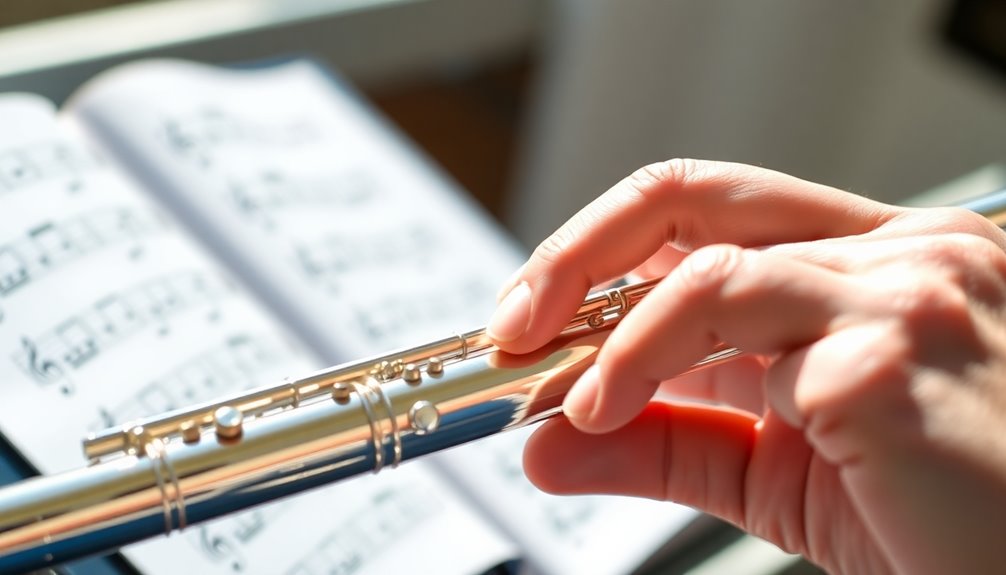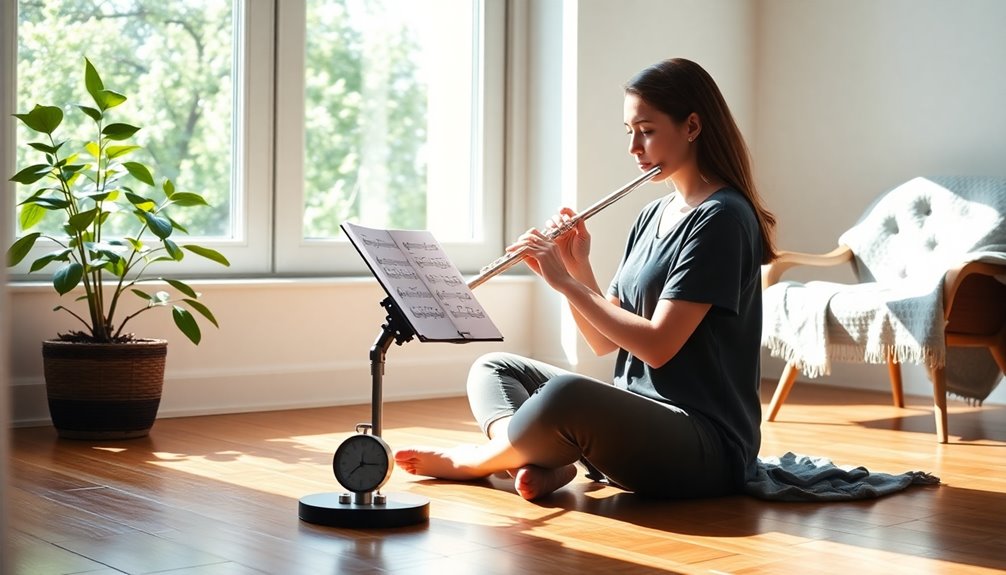To play high notes on the flute without stress, start by refining your embouchure; form a small, round "O" with your lips for better airflow. Take deep breaths, expanding your belly to support sound production. Practice rolling your fingers smoothly on and off keys to build dexterity, and try visualizing the upcoming notes to enhance coordination. Consistent practice with specific goals and warm-up exercises will strengthen your skills. Mental strategies, like positive affirmations and deep breathing, will help manage anxiety. With these techniques, you'll find playing high notes becomes easier and more enjoyable, leading to further insights on mastery.
Key Takeaways
- Maintain a well-formed embouchure by keeping lips firm yet flexible, using a small, round "O" shape for better air direction.
- Focus on proper breath support with deep diaphragmatic breaths, ensuring your belly expands and core muscles are engaged.
- Practice finger dexterity through scales and arpeggios, allowing for relaxed hand positioning and minimal finger movement during transitions.
- Utilize visualization and positive affirmations to build confidence and reduce performance anxiety before playing high notes.
- Seek professional guidance through lessons and workshops for tailored feedback and support in mastering high note techniques.
Understanding Flute High Notes

Understanding flute high notes can feel intimidating, but with the right approach, you can master them. High notes are an essential part of your flute range, allowing you to express a wide array of emotions and musical ideas.
To get started, focus on your embouchure. A well-formed embouchure sets the foundation for effective note production. Make certain your lips are firm yet flexible, directing the air stream precisely across the flute's lip plate.
Next, practice your fingerings for higher notes. Familiarize yourself with the specific fingerings required for the notes you want to play. High notes often require subtle adjustments, so don't hesitate to experiment. Use a tuner to verify you're hitting the right pitches; it'll help you develop your ear for those elusive high notes.
Another important aspect is your air support. While we won't delve into breath support techniques just yet, remember that high notes require a steady stream of air. Visualize your air as a focused beam, guiding it through your instrument. This will enhance both your control and your ability to sustain those notes.
Finally, don't shy away from repetition. Consistent practice will build your confidence and enhance your familiarity with high notes. Play along with recordings or join a group; it's a great way to feel connected to others who share your passion. Developing embouchure strength will further assist you in achieving a clearer and more resonant sound in the higher register.
With patience and dedication, you'll find that high notes become an exciting and rewarding part of your flute journey!
Proper Breath Support Techniques

Consistently applying proper breath support techniques is essential for playing high notes on the flute effectively. Start by focusing on diaphragm control. Your diaphragm acts as a key player in breath support. When you inhale, let your belly expand rather than just your chest. This deep breath allows you to take in more air, setting a solid foundation for your high notes.
As you prepare to play, think about breath timing. Timing your breaths correctly is vital to maintain a steady airflow. Instead of gasping for air mid-phrase, aim to take quick, efficient breaths during rests or less demanding sections of music. This way, you'll have ample air when it's time to tackle those higher pitches.
When you're ready to produce a high note, engage your core muscles while maintaining relaxed shoulders. This combination allows you to push the air up steadily, giving you control over the pitch and volume. Remember, it's not just about blowing harder; it's about directing your airflow with intention. Proper posture and core engagement also play a critical role in optimizing your breath support.
Practice exercises that require you to sustain long notes while focusing on even airflow. This will enhance your diaphragm control and overall breath support. As you develop these skills, you'll notice a significant improvement in your ability to reach those challenging high notes with ease.
Adjusting Your Embouchure

Your embouchure is vital for hitting those high notes on the flute effectively. To achieve that beautiful, clear sound, you need to focus on your lip position and guarantee you're allowing for embouchure flexibility.
Start by placing your lips together gently, not too tight or loose. Imagine the shape of a small, round "O" while keeping your corners firm but relaxed. This shape helps direct the airstream efficiently, essential for reaching those higher pitches.
Next, practice adjusting your lip position slightly. Experiment with bringing your bottom lip forward or rolling it in a bit. You might find that a small adjustment can make a big difference in your tone.
Don't be afraid to play around with how your lips interact with the flute. It's all about finding what works best for you.
As you play, pay attention to how your embouchure responds to different notes. The more flexible your embouchure, the easier it'll be to navigate through challenging passages. Mastery of tongue placement is also essential for initiating clear sound.
If you notice any strain or discomfort, take a break and reassess your lip position.
Finger Placement and Coordination

Mastering finger placement and coordination is vital for playing high notes on the flute with precision and ease. To achieve this, focus on your hand positioning first. Make certain your hands are relaxed and your fingers are curved naturally, allowing for peak movement. Position your left hand near the top of the flute, with your thumb resting comfortably on the thumb key, while your right hand should be slightly lower, fingers hovering over the keys.
Finger flexibility plays an important role in executing high notes. Practice rolling your fingers on and off the keys with a gentle touch. This exercise not only builds dexterity but also helps you avoid tension in your hands and wrists. Remember, a relaxed approach leads to better control and accuracy as you navigate those tricky high notes.
As you work on finger coordination, try to minimize any unnecessary movements. When you lift one finger, make certain the others stay close to their keys, ready to engage. This streamlined motion minimizes the risk of missing notes and allows for quicker shifts. It can be helpful to visualize the notes you're about to play, preparing your fingers to respond instinctively.
Lastly, don't underestimate the power of consistent practice. Spend time focusing specifically on challenging passages, making certain your fingers move fluidly and confidently. Using anti-slip thumb rests can further enhance your comfort and control while playing high notes.
With patience and dedication, you'll find that high notes become more accessible, and your overall playing will flourish. Remember, you're not alone on this journey; we're all working for improvement together!
Warm-Up Exercises for High Notes

A solid warm-up routine is essential for preparing to hit those high notes on the flute. Start by focusing on your breath. Take a deep inhale through your nose, allowing your diaphragm to expand. As you exhale, produce a steady tone on a comfortable low note. This will help you establish a solid foundation for your higher register.
Next, practice long tones. Choose a note in your middle register, and hold it for as long as you can while maintaining a steady sound. Gradually work your way up to higher notes, aiming for clarity and consistency. Remember, it's not about volume; focus on producing a pure tone.
Incorporate lip slurs into your warm-up. Begin on a low note and slur upwards to a high note, then back down. This exercise encourages flexibility in your embouchure, which is vital for maneuvering those challenging high notes.
You can also try scales, but focus on the upper octave. Play slowly, ensuring each note is clean and in tune.
Don't forget to include articulation exercises. Practice tonguing on high notes using different articulations—like staccato and legato—to build control. Additionally, focusing on diaphragmatic breathing can significantly enhance your ability to sustain high pitches with ease.
As you warm up, visualize yourself effortlessly hitting those high notes, and remind yourself that practice makes perfect.
Utilizing Flute Dynamics

Dynamic control on the flute adds depth and expression to your playing, allowing you to convey emotion and nuance. By mastering dynamic contrast, you can create a more engaging performance that resonates with your audience. Start by exploring the full range of dynamics—from soft, delicate notes to powerful, resonant sounds.
Practice playing scales and simple melodies at varying volumes, intentionally emphasizing the differences. When you're playing high notes, remember that dynamics can help you navigate the challenges they present. For instance, playing a high note softly can often make it easier to achieve better intonation and control.
Experiment with gentle crescendos and decrescendos to add shape to your phrases. This not only enhances your expressive phrasing but also makes the music feel more alive.
Listen to recordings of accomplished flutists and pay attention to how they use dynamics. Notice how subtle shifts in volume can transform a piece. Try to replicate their dynamic choices in your practice sessions. You might even consider recording yourself to identify areas for improvement.
Incorporate dynamic contrast into your practice repertoire. Choose pieces that naturally lend themselves to expression and focus on the emotional impact of your dynamics. Remember, it's not just about hitting the right notes; it's about telling a story through your music.
As you develop this skill, you'll notice how much more connected you feel to your instrument and your audience. Keep pushing your boundaries, and you'll find that dynamic control is a key to revealing your true potential on the flute. Additionally, regular maintenance using a quality flute care kit can help ensure your instrument responds beautifully to your dynamic expressions.
Mental Strategies for Confidence

Building confidence in your flute playing can greatly enhance your ability to tackle high notes and express yourself musically. One effective way to boost your confidence is through visualization techniques. Before you even pick up your flute, take a moment to close your eyes and imagine yourself playing those high notes effortlessly.
Picture the sound filling the room and the audience responding positively. This mental rehearsal not only prepares you for performance but also reinforces your belief in your abilities.
Positive affirmations are another powerful tool. Start each practice session by affirming your skills and potential. Say things like, "I'm capable of hitting those high notes," or "I play with confidence and ease."
Repeating these phrases can help shift your mindset and create a more positive internal dialogue. You can even write them down and place them where you practice for constant reminders.
Additionally, consider using deep breathing techniques to calm any nerves before playing. Take a few deep breaths, allowing yourself to relax and focus.
This simple practice can ground you and enhance your overall confidence. Incorporating mindful breathing into your routine further supports your ability to manage stress and play with ease.
Regular Practice Routines

Establishing a regular practice routine is vital for mastering high notes on the flute. To make real progress, you need consistent schedules that fit seamlessly into your life. Start by setting aside specific times each day for practice. Whether it's early morning or late evening, find what works best for you and stick to it. This consistency won't only build your muscle memory but also reinforce a sense of commitment to your craft.
During your practice sessions, focus is key. Design your time to include specific goals, like hitting those challenging high notes. Begin each session with warm-ups, gradually increasing the difficulty as you progress. Try incorporating long tones and scales that target the higher register. This helps you develop control over your breath and embouchure, which are essential for those high notes. Regular practice of scales and arpeggios enhances finger dexterity and breath control, aiding in your pursuit of high notes.
Don't forget to break your practice into focused sessions. Instead of trying to cram everything into one long practice, consider shorter, intense bursts of activity. For instance, dedicate 20 minutes to high notes, followed by a few minutes of rest to let the information sink in. This approach can help prevent burnout and keep your enthusiasm high.
Troubleshooting Common Issues

Even with a solid practice routine, you might encounter challenges when trying to hit those high notes on the flute. Troubleshooting these issues can help you improve your tone production and breath control, leading to a more satisfying playing experience. Here are some common problems and solutions to keep in mind:
| Issue | Possible Cause | Solution |
|---|---|---|
| Weak tone in high register | Insufficient breath support | Focus on deep diaphragmatic breathing. Use exercises to strengthen your breath control. |
| Uncontrolled pitch | Tension in embouchure | Relax your lips and jaw. Try different embouchure shapes to find what works best for you. |
| Difficulty hitting notes | Incorrect finger placement | Double-check your fingering. Practice slowly, ensuring each finger lands accurately. |
| Fatigue while playing | Poor posture or positioning | Adjust your seating and hold your flute comfortably. Remember, a relaxed body supports better breath control. |
Incorporating breathing exercises into your daily routine can significantly enhance your overall control and ease of playing high notes.
Seeking Professional Guidance

Seeking professional guidance can be a game-changer in your journey to master high notes on the flute. When you consider private lessons, you're opening the door to tailored instruction that addresses your unique challenges and aspirations. A skilled teacher can provide you with the tools and techniques necessary to play those elusive high notes confidently.
During your lessons, focus on specific exercises designed to strengthen your embouchure and enhance your breath control. Your instructor will likely incorporate warm-up routines that target higher registers, helping you to gradually ease into playing those notes without strain.
Don't hesitate to ask for expert feedback—this is invaluable. Constructive criticism can help you identify areas for improvement and reinforce your strengths.
It's essential to build a rapport with your teacher. Feel comfortable discussing your goals and any fears you may have about playing high notes. This open communication fosters a supportive learning environment where you can thrive.
Your teacher can offer personalized strategies to help you overcome anxiety, making the process enjoyable. Additionally, consider joining group classes or workshops. These settings can provide a sense of community, allowing you to connect with fellow flutists who share similar challenges.
Furthermore, selecting a good quality flute, such as those from beginner-friendly brands, can enhance your ability to reach high notes more easily.
Frequently Asked Questions
What Common Mistakes Do Beginners Make With High Notes?
When you're starting out, common mistakes with high notes often stem from inadequate breath support and improper embouchure adjustment.
You might be holding your breath or tightening your lips, which can hinder your sound. Focus on breathing deeply from your diaphragm and relaxing your mouth.
Make small adjustments to your embouchure, experimenting until you find what works. Remember, everyone makes mistakes—it's part of learning!
Keep practicing, and you'll improve in no time.
How Can I Reduce Tension in My Hands While Playing?
Imagine you're gripping a hot cup of tea too tightly, feeling the heat and tension in your hands.
To reduce tension, focus on your hand positioning. Keep your fingers relaxed and curved, resting lightly on the keys.
Try to consciously engage in muscle relaxation techniques, like shaking out your hands before playing.
You'll find that a gentle grip allows for better control and comfort, making your flute experience much more enjoyable.
Are There Specific Flutes Better for High Notes?
When you're choosing a flute for high notes, consider headjoint materials like silver or gold, which can enhance your sound quality.
Brands like Yamaha and Powell offer models specifically designed for better intonation in the upper register.
Don't hesitate to try different flutes; finding the right one can make all the difference.
How Does Climate Affect Playing High Notes on the Flute?
Imagine standing under a summer sun, feeling the warmth on your skin.
Climate plays a big role in how you hit those high notes on the flute. Humidity affects how your instrument responds; too much moisture can make it sluggish, while dry air makes it sharp.
Temperature variations can also alter your flute's tuning. Keep your flute in a stable environment, and you'll find it easier to play those soaring notes with confidence.
Can Diet Impact My Ability to Play High Notes?
Yes, your diet can definitely impact your ability to play high notes. Focus on nutrition tips like incorporating fruits and vegetables for vitamins and minerals that support your respiratory health.
Hydration's important too; staying well-hydrated helps keep your throat and vocal cords in top condition.
Before playing, consider a light snack to boost your energy.
With these small adjustments, you'll feel more confident and capable, helping you reach those high notes effortlessly!
Conclusion
Playing high notes on the flute is like reaching for the stars—challenging yet rewarding. By mastering breath support, adjusting your embouchure, and practicing regularly, you'll build the confidence needed to soar. Think of each note as a stepping stone leading you to greater heights. Embrace the journey, troubleshoot your challenges, and don't hesitate to seek guidance when needed. With patience and persistence, you'll find your voice in the upper register, shining brightly like a star in the night sky.






